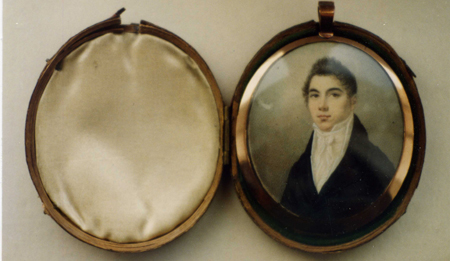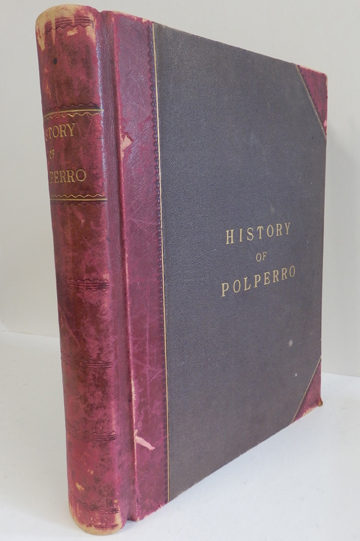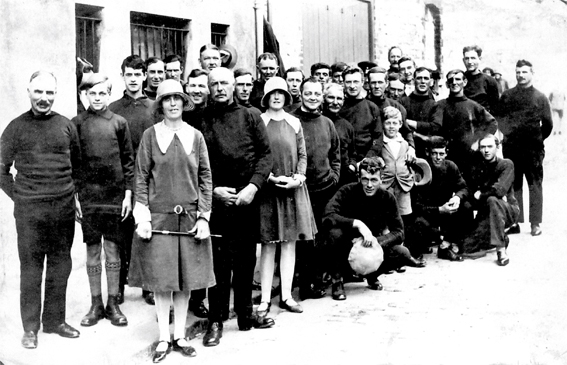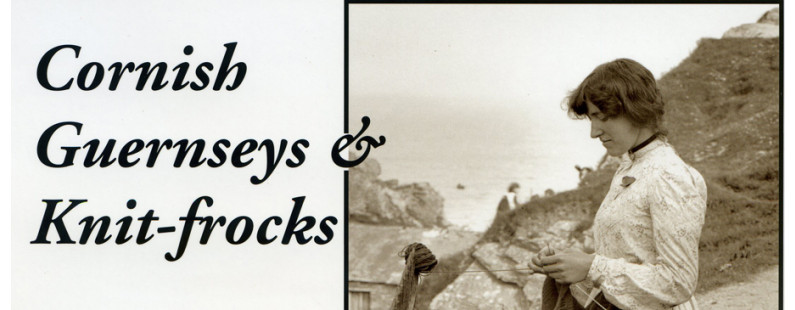Polperro Postscripts
A blog for anyone with an interest in Polperro, publishing and people... with occasional musings on history and humanity.
Subscribe
Recent Posts
A descendant of Jonathan Couch, the Polperro surgeon and naturalist, recently came across a hitherto unknown miniature portrait of him as a young man.
 A note attached to the glass case which housed the miniature portrait gives the date as 1808 and Jonathan Couch’s age as 19. It is almost certainly the miniature he referred to in an account inserted into his Private Memoirs, written in January 1811 shortly after the death of his first wife Jane Prynn Rundle. In 1809, he secured a place at the combined Guy’s and St. Thomas’s teaching hospitals in London and corresponded regularly with his first love Jane who lived at Porthallow above Talland Bay. Couch appears to have commissioned the work by the Italian miniaturist Joseph Pastorini.*
A note attached to the glass case which housed the miniature portrait gives the date as 1808 and Jonathan Couch’s age as 19. It is almost certainly the miniature he referred to in an account inserted into his Private Memoirs, written in January 1811 shortly after the death of his first wife Jane Prynn Rundle. In 1809, he secured a place at the combined Guy’s and St. Thomas’s teaching hospitals in London and corresponded regularly with his first love Jane who lived at Porthallow above Talland Bay. Couch appears to have commissioned the work by the Italian miniaturist Joseph Pastorini.*
‘When in London her letters breathed the most ardent and constant affection; about two months after I had been there I transmitted to her, by the hands of George, then going down the county from Devon, my miniature which I had promised her. It was drawn by Pastorini and the hair on the reverse is hers…’
Couch’s passionate courtship of Jane Rundle continued throughout his time as a medical student in London. The couple were very much in love when, early in 1810, Jane discovered she was expecting a baby. Her parents may well have persuaded her to withhold the news from him until he had finally completed his medical studies and returned to Polperro later that year. In any event, they were married at Talland in August but tragically Jane died shortly after giving birth to a baby girl in October.
In later life, Jonathan Couch often reflected: ‘In twelve months I was a young man, a married man, a father and a widower’.
His first daughter, also named Jane, went on to marry and have six children of her own. Couch himself remarried twice, becoming the father of eleven children and living until the age of 81. Today, he is remembered as a pioneering man of medicine and the natural world, the author of many books and articles as well as a noted local historian.
*Joseph Pastorini (1775-1839) exhibited at the Royal Academy in London 1812-1834.

Jonathan Couch (1789-1870), the surgeon apothecary of Polperro who became one of the pioneering natural historians of his day, is largely remembered for his many publications during his lifetime including his four-volume Fishes of the British Islands.
A hitherto unknown manuscript edition of his History of Polperro has been discovered more than 150 years after it was written in 1847, three years before the author’s death in 1870. A later edition of the History of Polperro, edited by his son Thomas Quiller Couch, was subsequently published in 1871.
The large bound volume consists of 160 pages written in Jonathan Couch’s copperplate handwriting, amounting to nearly 34,000 words and appears to be an early draft version of the History of Polperro that was eventually published. The two versions differ markedly however. Couch’s original draft includes chapters on the storms of 1817 and 1824, the harbours and piers, fishery, trade and religious history, much of which does not appear in the final published edition.
The manuscript is accompanied by an Index compiled by one of the volume’s early owners, Henry Lee Rowett (1844-1922), in 1898.

Polperro Fishermen's Choir Centenary
Polperro Fishermen's Choir celebrates 100 years
Posted on February 8, 2023

The Polperro Fishermen’s Choir celebrates its centenary this year. Founded in 1923 (pictured above), it has continued to perform for audiences ever since, raising funds for charity. For many years the prosperity of Polperro depended on the pilchard industry. The fishermen were a hardy breed of men and the Chapel had a great influence on their lives. They were devout men who would sing as they worked their boats; and not surprisingly many of these songs were hymns that were sung in Chapel on a Sunday. When the pilchard fishing began to decline; the singing did not.
It was Eva Cloke, the organist at the Chapel and Thomas Mark, a lay preacher known locally as the ‘Fishermen’s Bishop’ who realised the need to establish the Polperro Fishermen’s Choir in 1923. The choir would sing hymns and religious style songs in Chapel on Sundays and at Harvest of the Sea services as well as other religious fishing festivals around the county in the 1920s and 1930s. The choir’s reputation grew and they were soon singing regularly in the village and in different parts of Cornwall. At the time some 90 per cent of the choir were fishermen from Polperro.
But, with the decline of the fishing industry, the choir suffered losses until other tradesmen from around the village joined in. It was disbanded for the duration of World War II but was reformed in 1951. The Choir’s ‘uniform’ in the early days was a rough knitted roll-neck gansey, knitted by the wives and daughters for their men folk. Each man could be identified by the pattern of his gansey, a tradition which had continued down the years. In 1982 the choir ‘modernised’ and adopted a black blazer with badge and a roll neck shirt or sweater.
After Eva Cloke’s death in 1969, the choir continued to perform concerts not just in Polperro but throughout southern England, including television appearances for both BBC and ITV as well as recordings for BBC Radio, Radio Cornwall and Plymouth Sound. Other performances included visits to Quiberon in France and the Royal Albert Hall in London.
In 1973 the choir celebrated its Golden Jubilee year by making their first long-playing record entitled ‘Sounds like Polperro’ which became a best seller and remains a favourite today. This was quickly followed by ‘Polperro Sings Again’; ‘When evenings Twilight’; ‘Tis Christmas time’; ‘Born In Song’ and ‘Polperro Sails’. In 1992 almost all the choirs in Cornwall sang together at Truro Cathedral to a full capacity audience.
The tradition of the Choir runs deep within the original Fishermen’s Choir families. Phil Carrigan became the musical director in 1999, having served with distinction in Her Majesty’s Band of the Royal Marines. He has played before the late Queen and the Queen Mother as well as concerts around the world including Washington D.C. and the West Indies. Probably his greatest claim to fame is when he lost his bass drum over the side while on parade on the flight deck of HMS Ark Royal in 1971 much to the amusement of the captive audience. It is said the entire ship’s company spontaneously broke into a chorus of ‘Sailing’ thus pre-empting their now famous recording!


